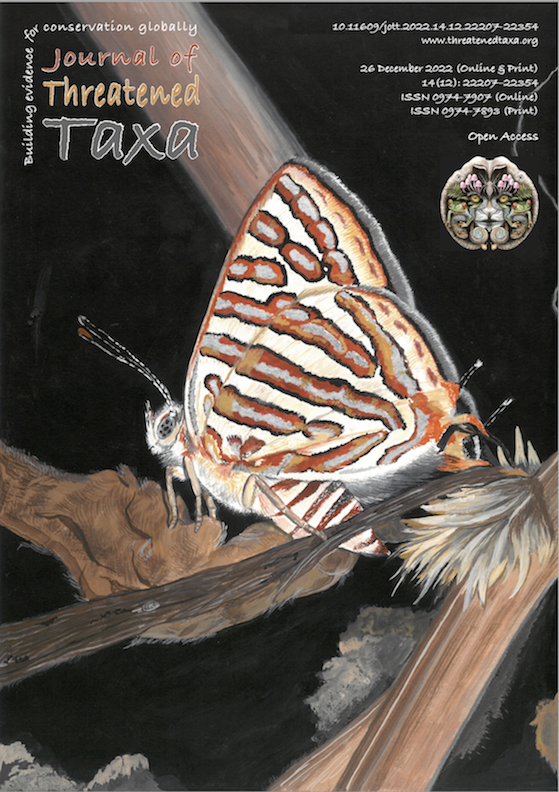Mercury in tuna from the western equatorial Atlantic Ocean and health risk assessment
Main Article Content
Abstract
This study analyses the mercury (Hg) concentration in the meat of Thunnus albacares and Thunnus obesus caught from the western equatorial Atlantic Ocean. The objective was to estimate the Hg intake via tuna ingestion and presents the possible health risk assessment. For T. albacares and T. obesus, the median concentration was 212 ng·g-1 and 475.1 ng·g-1 wet weight, respectively. The Hg concentrations were below the maximum tolerable limit established by international and Brazilian regulations for fishery products. The consumption would pose a risk for human populations that ingest more than 80 g·day-1. Regular monitoring of both human consumption rates and Hg levels in fish are recommended.
Article Details

This work is licensed under a Creative Commons Attribution 4.0 International License.
Authors own the copyright to the articles published in JoTT. This is indicated explicitly in each publication. The authors grant permission to the publisher Wildlife Information Liaison Development (WILD) Society to publish the article in the Journal of Threatened Taxa. The authors recognize WILD as the original publisher, and to sell hard copies of the Journal and article to any buyer. JoTT is registered under the Creative Commons Attribution 4.0 International License (CC BY), which allows authors to retain copyright ownership. Under this license the authors allow anyone to download, cite, use the data, modify, reprint, copy and distribute provided the authors and source of publication are credited through appropriate citations (e.g., Son et al. (2016). Bats (Mammalia: Chiroptera) of the southeastern Truong Son Mountains, Quang Ngai Province, Vietnam. Journal of Threatened Taxa 8(7): 8953–8969. https://doi.org/10.11609/jott.2785.8.7.8953-8969). Users of the data do not require specific permission from the authors or the publisher.
Funding data
-
Conselho Nacional de Desenvolvimento Científico e Tecnológico
Grant numbers 302.598/2021-9 and 305.217/2017-8 -
Fundação Carlos Chagas Filho de Amparo à Pesquisa do Estado do Rio de Janeiro
Grant numbers E-26/200.797/2021, E-26/210.703/2021 and E-26/200.586/2022
References
ANVISA - Agência Nacional de Vigilância Sanitária (2021). Estabelece os limites máximos tolerados (LMT) de contaminantes em alimentos. Diário Oficial [da] República Federativa do Brasil. https://www.in.gov.br/en/web/dou/-/instrucao-normativa-in-n-88-de-26-de-marco-de-2021-311655598
Barone, R.S.C., E.K. Lorenz, D.Y. Sonoda & J.E.P. Cyrino (2017). Fish and fishery products trade in Brazil, 2005 to 2015: a review of available data and trends. Scientia Agricola 74: 417–424. https://doi.org/10.1590/1678-992X-2016-0300
Bastos, W.R., O. Malm, W.C. Pfeiffer & D. Cleary (1998). Establishment and analytical quality control of laboratories for Hg determination in biological and geological samples in the Amazon, Brazil. Ciência e Cultura 50: 255–260.
Caldas, D., I.A. Pestana, F.C. Henry, M.S.M.B. Salomão & C.M.M. Souza (2016). Risk of ingesting As, Cd, and Pb in animal products in north Rio de Janeiro state, Brazil. Chemosphere 164: 508–515. https://doi.org/10.1016/j.chemosphere.2016.08.130
Choy, C.A., B.N. Popp, J.J. Kanekoc & J.C. Drazena (2009). The influence of depth on mercury levels in pelagic fishes and their prey. Proceedings of the National Academy of Sciences 106: 13865–13869. https://doi.org/10.1073/pnas.0900711106
FAO (2020). The State of World Fisheries and Aquaculture 2020. Sustainability in Action. Food and Aquaculture Organization of the United Nations, Rome. https://doi.org/10.4060/ca9229en
FAO/WHO (1991). Report of the Nineteenth Session of the Joint FAO/WHO Codex Alimentarius Commission. Food and Agriculture Organization of the United Nations/World Health Organization. https://www.fao.org/3/t0490e/T0490E01.htm
FAO/WHO (2003). Summary of Evaluations Performed by the
Joint FAO/WHO Expert Committee on Food Additives. Food and Agriculture Organization of the United Nations/World Health Organization. https://inchem.org/documents/jecfa/jeceval/jec_1509.htm
Ferriss, B.E. & T.E. Essington (2011). Regional patterns in mercury and selenium concentrations of Yellowfin Tuna (Thunnus albacares) and Bigeye Tuna (Thunnus obesus) in the Pacific Ocean. Canadian Journal of Fishery and Aquatic Science 68: 2046─2056. https://doi.org/10.1139/f2011-120
Jinadasa, B.K.K.K., G.S. Chathurika, G.D.T.M. Jayasinghe & C.D. Jayaweera (2019). Mercury and cadmium distribution in Yellowfin Tuna (Thunnus albacares) from two fishing grounds in the Indian Ocean near Sri Lanka. Heliyon 5: e01875. https://doi.org/10.1016/j.heliyon.2019.e01875
Guillotreau, P., D. Squires, J. Sun & G.A. Compeán (2017). Local, regional and global markets: what drives the tuna fisheries? Reviews in Fish Biology and Fisheries 27: 909–929. https://doi.org/10.1007/s11160-016-9456-8.
Khitalishvili, K. (2016). Monte Carlo simulation in R: basic example. Available at: https://rpubs.com/Koba/Monte-Carlo-Basic-Example
Lacerda, L.D., F. Goyanna, M.F. Bezerra & G.B. Silva (2017). Mercury concentrations in Tuna (Thunnus albacares and Thunnus obesus) from the Brazilian Equatorial Atlantic Ocean. Bulletin of Environmental Contamination and Toxicology 98: 149–155. https://doi.org/10.1007/s00128-016-2007-0
Lescord, G.L., T.A. Johnston, B.A. Branfireun & J.M. Gunn (2018). Percentage of methylmercury in the muscle tissue of freshwater fish varies with body size and age and among species. Environmental Toxicology and Chemistry 37: 2682–2691. https://doi.org/10.1002/etc.4233
R Core Team (2022). R: A language and environment for
statistical computing. R Foundation for Statistical Computing, Vienna, Austria. Available at: https://www.r-project.org/
Rodrigues, S.L., V.G.O. Carneiro, A.J.R. Freitas & H.A. Andrade (2020). Spatiotemporal variability of target-species in tuna and tuna-like fishing in Brazil. Boletim do Instituto de Pesca 46: e587. https://doi.org/10.20950/1678-2305.2020.46.2.587
Tseng, C.M., S.J. Ang, Y.S. Chen, J.C. Shiao, C.H. Lamborg, X. He & J.R. Reinfeld (2021). Bluefin tuna reveal global patterns of mercury pollution and bioavailability in the world’s oceans. The Proceedings of the National Academy of Sciences 118: e2111205118. https://doi.org/10.1073/pnas.2111205118

